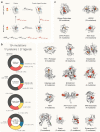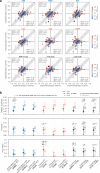Accurate Estimation of Ligand Binding Affinity Changes upon Protein Mutation
- PMID: 30648154
- PMCID: PMC6311686
- DOI: 10.1021/acscentsci.8b00717
Accurate Estimation of Ligand Binding Affinity Changes upon Protein Mutation
Abstract
The design of proteins with novel ligand-binding functions holds great potential for application in biomedicine and biotechnology. However, our ability to engineer ligand-binding proteins is still limited, and current approaches rely primarily on experimentation. Computation could reduce the cost of the development process and would allow rigorous testing of our understanding of the principles governing molecular recognition. While computational methods have proven successful in the early stages of the discovery process, optimization approaches that can quantitatively predict ligand affinity changes upon protein mutation are still lacking. Here, we assess the ability of free energy calculations based on first-principles statistical mechanics, as well as the latest Rosetta protocols, to quantitatively predict such affinity changes on a challenging set of 134 mutations. After evaluating different protocols with computational efficiency in mind, we investigate the performance of different force fields. We show that both the free energy calculations and Rosetta are able to quantitatively predict changes in ligand binding affinity upon protein mutations, yet the best predictions are the result of combining the estimates of both methods. These closely match the experimentally determined ΔΔG values, with a root-mean-square error of 1.2 kcal/mol for the full benchmark set and of 0.8 kcal/mol for a subset of protein systems providing the most reproducible results. The currently achievable accuracy offers the prospect of being able to employ computation for the optimization of ligand-binding proteins as well as the prediction of drug resistance.
Conflict of interest statement
The authors declare no competing financial interest.
Figures




References
-
- de Wolf F. A.; Brett G. M. Ligand-Binding Proteins: Their Potential for Application in Systems for Controlled Delivery and Uptake of Ligands. Pharmacol. Rev. 2000, 52 (2), 207–236. - PubMed
LinkOut - more resources
Full Text Sources

